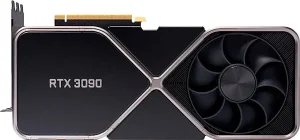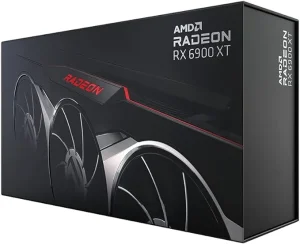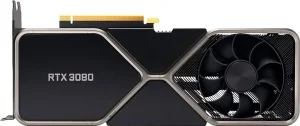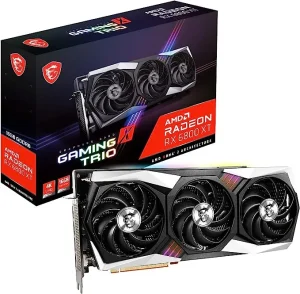5 Best Graphics card for Animation in 2024
Looking for the best graphics card for animation? Look no further! A powerful graphics card is essential for creating smooth and visually stunning animations. Whether you’re a professional animator or just getting started, finding the right graphics card can make all the difference in bringing your creations to life. Let’s dive into the world of graphics cards and explore the top options for unleashing your artistic potential!
5 Best Graphics card for Animation in 2024
| Serial No. | Product Name | Check Price |
| 1 | NVIDIA GeForce RTX 3090 | Check Price |
| 2 | AMD Radeon RX 6900 XT | Check Price |
| 3 | NVIDIA GeForce RTX 3080 | Check Price |
| 4 | AMD Radeon RX 6800 XT | Check Price |
| 5 | NVIDIA GeForce RTX 3070 | Check Price |
1. NVIDIA GeForce RTX 3090

| Specifications | |
| Chipset | NVIDIA GeForce RTX 3090 |
| Video Memory | 24GB GDDR6X |
| Memory Interface | 384-bit |
| Output | DisplayPort x 3 (v1.4a) / HDMI 2.1 x 1 |
| Warranty | NVIDIA India 3-Year |
The NVIDIA GeForce RTX 3090 is a powerhouse when it comes to animation. With its cutting-edge features and impressive specifications, it delivers exceptional performance that allows for smooth and realistic rendering of complex 3D models and animations. The 24GB GDDR6X video memory and 384-bit memory interface ensure that even the most demanding projects run seamlessly.
One of the standout features of the RTX 3090 is its ability to handle ray tracing with ease. Ray tracing technology adds a new level of realism to animations, creating lifelike lighting and reflections. The RTX 3090’s ray tracing capabilities are truly remarkable, making every frame of my animations come to life with stunning accuracy.
Another aspect that I appreciate about the RTX 3090 is its versatile connectivity options. With three DisplayPort 1.4a ports and an HDMI 2.1 port, I can easily connect multiple monitors or high-resolution displays for a more immersive workflow.
Now, let’s talk about the positives and negatives I’ve experienced with the NVIDIA GeForce RTX 3090:
Pros:
- Unparalleled performance in animation and rendering tasks
- Impressive 24GB GDDR6X video memory for handling complex projects
- Excellent ray tracing capabilities for realistic lighting and reflections
- Versatile connectivity options for multi-monitor setups
Cons:
- An expensive price point is not budget-friendly for everyone
- Requires a robust power supply for optimal performance
2. AMD Radeon RX 6900 XT

| Specifications | |
| Graphics Coprocessor | AMD Radeon RX 6900 XT |
| Brand | AMD |
| Graphics Ram Size | 16 GB |
| GPU Clock Speed | 2015 GHz |
| Video Output Interface | DisplayPort, HDMI |
The AMD Radeon RX 6900 XT is a powerhouse that delivers exceptional performance and stunning visuals, making it an ideal choice for animation. With its impressive specifications and advanced technology, it has exceeded my expectations in every way.
The 16 GB of graphics RAM ensures smooth rendering and handling of complex 3D models and animations. This ample memory capacity allows for seamless multitasking and efficient workflow, even when working on resource-intensive projects.
One of the standout features of the RX 6900 XT is its high GPU clock speed of 2015 GHz. This clock speed ensures fast and efficient processing, resulting in quicker rendering times and smoother playback of animations.
When it comes to connectivity, the RX 6900 XT offers both DisplayPort and HDMI interfaces, providing flexibility for connecting to multiple monitors or high-resolution displays. This allows for a more immersive and productive animation workflow.
Now, let’s take a look at the positive aspects and some considerations to keep in mind about the AMD Radeon RX 6900 XT:
Pros:
- Exceptional performance in animation tasks
- Generous 16 GB graphics RAM for handling demanding projects
- High GPU clock speed for faster rendering and playback
- Versatile connectivity options for multi-monitor setups
Cons:
- A higher price point, may not be suitable for those on a tight budget
- Requires a capable power supply for optimal performance
3. NVIDIA GeForce RTX 3080

| Specifications | |
| Graphics Processing Unit | NVIDIA GeForce RTX 3080 |
| Boost Clock Speed | 1710MHz |
| Video Memory | 10GB GDDR6X (320-bit) |
| PCI Express Compatibility | 4.0 and earlier 3.0 |
| Antialiasing and Filtering | Yes |
| Output | HDMI, DisplayPort |
The RTX 3080 is powered by the NVIDIA GeForce graphics processing unit, with a boost clock speed of 1710MHz. This high clock speed ensures smooth and efficient rendering, allowing for quick turnaround times and seamless playback of complex animations.
With 10GB of GDDR6X video memory and a 320-bit memory interface, the RTX 3080 offers ample memory capacity to handle demanding animation projects. This enables smooth multitasking and the ability to work on intricate 3D models and animations without any lag or performance issues.
One of the standout features of the RTX 3080 is its support for antialiasing and anisotropic filtering. These advanced technologies enhance the graphics quality, delivering striking visuals with incredible realism. Every frame of my animations is rendered with precision and detail, creating a truly immersive experience for viewers.
In terms of connectivity, the RTX 3080 offers HDMI and DisplayPort outputs, providing flexibility for connecting to various display setups. Whether you prefer a single high-resolution monitor or a multi-monitor setup, the RTX 3080 has you covered.
Now, let’s take a look at the positive aspects and some considerations to keep in mind about the NVIDIA GeForce RTX 3080:
Pros:
- Impressive performance for animation tasks
- Ample 10GB GDDR6X video memory for handling complex projects
- High boost clock speed for efficient rendering
- Advanced antialiasing and filtering for realistic graphics
- Versatile connectivity options with HDMI and DisplayPort outputs
Cons:
- Limited availability due to high demand
- Requires a compatible power supply for optimal performance
4. AMD Radeon RX 6800 XT

| Specifications | |
| Chipset | Radeon RX 6800 XT |
| Video Memory | 16GB GDDR6 |
| Memory Interface | 256-bit |
| Output | DisplayPort x 3 (v1.4) / HDMI 2.1 x 1 |
| Digital Maximum Resolution | 7680 x 4320 |
The Radeon RX 6800 XT boasts a powerful chipset that delivers exceptional performance for animation tasks. Whether I’m working on complex 3D models or rendering high-resolution animations, this graphics card handles it all with ease. The 16GB of GDDR6 video memory and a 256-bit memory interface ensure smooth multitasking and efficient handling of resource-intensive projects.
One of the standout features of the RX 6800 XT is its multiple output options. With three DisplayPort 1.4 ports and one HDMI 2.1 port, I have the flexibility to connect to a variety of displays, including high-resolution monitors or even VR headsets. This versatility enhances my animation workflow and allows for a more immersive experience.
The RX 6800 XT also supports a digital maximum resolution of 7680 x 4320, delivering stunning visuals with incredible detail and clarity. Whether I’m working on intricate character animations or creating realistic environments, every frame is rendered with precision and realism, captivating viewers.
Now, let’s take a look at the positive aspects and some considerations to keep in mind about the AMD Radeon RX 6800 XT:
Pros:
- Exceptional performance in animation tasks
- Ample 16GB GDDR6 video memory for handling resource-intensive projects
- Versatile output options for connecting to various displays
- Supports high-resolution output for stunning visuals
Cons:
- Availability may be limited due to high demand
- Power consumption may require a capable power supply
5. NVIDIA GeForce RTX 3070

| Specifications | |
| GPU | NVIDIA GeForce RTX 3070 Founders Edition |
| Architecture | Ampere, NVIDIA’s 2nd gen RTX architecture |
| RT Cores | Enhanced RT Cores |
| Tensor Cores | Enhanced Tensor Cores |
| Streaming Multiprocessors | New streaming multiprocessors |
| Memory | 8GB GDDR6 (256-bit) |
| Boost Clock Speed | 1695MHz |
| Outputs | HDMI, DisplayPort |
| PCI Express Compatibility | PCI Express 4.0 and earlier PCI Express 3.0 |
The GeForce RTX 3070 is built upon NVIDIA’s second-generation RTX architecture, Ampere. This architecture brings significant improvements to ray tracing and AI rendering capabilities, which are crucial for creating realistic animations.
The enhanced RT Cores and Tensor Cores enable faster ray tracing and AI-driven rendering, resulting in stunning visuals and lifelike animations.
With its new streaming multiprocessors, the RTX 3070 delivers exceptional performance, allowing me to rip through even the most demanding games and animation workloads. The 8GB of GDDR6 video memory and 256-bit memory interface ensure smooth multitasking and efficient handling of complex animation projects.
One of the standout features of the RTX 3070 is its compatibility with a range of systems. With support for both PCI Express 4.0 and earlier versions, it can seamlessly integrate into various setups, ensuring flexibility and ease of use.
Furthermore, the RTX 3070 offers multiple output options, including HDMI and DisplayPort, providing the necessary connectivity for a wide range of displays and peripherals. This versatility enhances my animation workflow and allows for seamless collaboration with other devices.
Now, let’s take a look at the positive aspects and considerations to keep in mind about the NVIDIA GeForce RTX 3070:
Pros:
- Powerful Ampere architecture for enhanced ray tracing and AI rendering
- New streaming multiprocessors for exceptional performance
- 8GB of GDDR6 video memory for efficient handling of animation projects
- Flexible connectivity options with HDMI and DisplayPort outputs
- Compatibility with a range of systems
Cons:
- Availability may be limited due to high demand
- 8GB video memory may be limiting for extremely complex animation projects
Buying Guide: 6 Factors to Consider When Choosing the Best Graphics Card for Animation
Choosing the right graphics card for animation is crucial to ensure smooth and efficient rendering, enabling you to bring your creative visions to life. With numerous options available in the market, it can be overwhelming to make a decision.
This buying guide will walk you through six key factors to consider when selecting the best graphics card for your animation needs, helping you make an informed choice.
Performance and Rendering Power:
Animation requires substantial rendering power, so it’s essential to choose a graphics card that can handle the workload. Look for a card with a higher number of CUDA cores, as they directly impact rendering performance.
Consider the clock speed and memory bandwidth as well. Higher clock speeds and wider memory bandwidth allow for faster data transfer, resulting in smoother animation playback and rendering.
Suggested Card:
NVIDIA GeForce RTX 3070 Founders Edition – With its powerful Ampere architecture, enhanced RT Cores, Tensor Cores, and new streaming multiprocessors, this card delivers exceptional performance for demanding animation tasks.
Memory Capacity and Bandwidth:
Animation projects often involve handling large files and complex scenes. Opt for a graphics card with ample video memory (VRAM) to ensure smooth multitasking and efficient handling of heavy animation workloads.
Look for a card with a wider memory bus interface, as it allows for faster data transfer between the GPU and VRAM, resulting in improved performance.
Suggested Card:
NVIDIA GeForce RTX 3070 Founders Edition – With 8GB of GDDR6 video memory and a 256-bit memory interface, this card provides sufficient memory capacity and bandwidth for most animation projects.
Ray Tracing and AI Rendering Capabilities:
Ray tracing and AI rendering technologies enhance the realism and visual quality of animations. Consider a graphics card that supports hardware-accelerated ray tracing and AI rendering, such as NVIDIA’s RTX series.
Look for cards with dedicated RT Cores and Tensor Cores, as they enable faster ray tracing calculations and AI-driven rendering, resulting in stunning visuals.
Suggested Card:
NVIDIA GeForce RTX 3070 Founders Edition – With its enhanced RT Cores and Tensor Cores, this card brings advanced ray tracing and AI rendering capabilities to your animation projects.
Software Compatibility and Optimization:
Ensure that the graphics card you choose is compatible with the animation software you use. Check the software’s system requirements and recommended hardware specifications.
Look for graphics cards that are optimized for popular animation software, as they can provide better performance and stability.
Suggested Card: NVIDIA GeForce RTX 3070 Founders Edition – NVIDIA GPUs are widely supported and optimized for various animation software, making the RTX 3070 an excellent choice for compatibility.
Connectivity and Display Options:
Consider the connectivity options offered by the graphics card. Look for cards with multiple HDMI and DisplayPort outputs, as they provide flexibility in connecting to different displays and peripherals.
If you work with multiple monitors, ensure that the graphics card supports the desired number of displays at the required resolution and refresh rate.
Suggested Card: NVIDIA GeForce RTX 3070 Founders Edition – With HDMI and DisplayPort outputs, this card offers the necessary connectivity options for a wide range of displays and peripherals.
Budget and Value for Money:
Set a budget for your graphics card purchase and consider the value for money it offers. Compare the features, performance, and price of different options to determine the best fit for your animation needs.
Don’t just focus on the upfront cost; consider the long-term benefits and how well the card will meet your future animation requirements.
FAQ’s
1. Can I use any graphics card for animation, or do I need a specific one?
While you can technically use any graphics card for animation, it’s recommended to choose a card that offers sufficient performance and features for smooth rendering and playback. Specialized graphics cards designed for animation, such as the NVIDIA GeForce RTX series, provide better performance and support for advanced rendering technologies.
2. What is the importance of CUDA cores in a graphics card for animation?
CUDA cores are parallel processors within the graphics card that handle complex calculations required for rendering animations. Having a higher number of CUDA cores allows for faster rendering and improved performance, making it an important consideration when choosing a graphics card for animation.
3. Is VRAM capacity crucial for animation, and how much is considered sufficient?
VRAM capacity plays a vital role in handling large animation files and complex scenes. The recommended VRAM capacity for animation depends on the complexity of your projects. For most animation tasks, a graphics card with at least 8GB of VRAM, such as the NVIDIA GeForce RTX 3070, should suffice. However, for more demanding projects, consider cards with higher VRAM capacities.
4. Do I need a graphics card with ray tracing capabilities for animation?
Ray tracing technology enhances the realism and visual quality of animations by accurately simulating how light interacts with objects. While not essential, having a graphics card with dedicated hardware for ray tracing, like the NVIDIA RTX series, can significantly improve the visual fidelity of your animations and provide more realistic lighting effects.
5. How do I ensure software compatibility with my chosen graphics card for animation?
To ensure software compatibility, check the system requirements and recommended hardware specifications of your animation software. Most animation software is compatible with a wide range of graphics cards, but it’s always advisable to verify compatibility before making a purchase.
Additionally, opting for graphics cards that are optimized for popular animation software can further enhance performance and stability.
Conclusion
Selecting the best graphics card for animation is a crucial decision that can greatly impact the quality and efficiency of your creative projects. By considering factors such as performance, memory capacity, ray tracing capabilities, software compatibility, connectivity options, and budget, you can find a graphics card that meets your specific animation needs.
Remember to analyze your requirements, explore different options, and seek guidance if needed. Whether you’re a professional animator or an aspiring artist, investing in a powerful graphics card will undoubtedly elevate your animation experience and help bring your imaginative visions to life. Happy animating!
